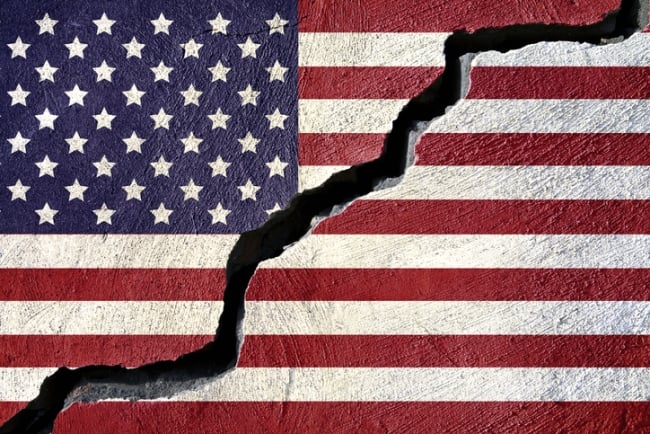You have /5 articles left.
Sign up for a free account or log in.

Jorge Villalba/iStock/Getty Images Plus
Americans agree on little these days, but they agree on this: the country is embroiled in a culture war. The signs are not hard to find. The draft Supreme Court decision by Justice Samuel Alito that would overturn Roe v. Wade claims the certainty of a culture warrior who wants to enshrine a particular ideology of what is “deeply rooted in the Nation’s history and traditions.” Populist governors invoke the rhetoric of battle as they style themselves protectors of the sanctity of families and the safety of children. In Florida, it wasn’t enough for Governor DeSantis to stoke panic about grooming gay children; when criticized, he attacked the “woke executives” from California hiding behind Mickey Mouse. Authoritarian Abbott of Texas is worried about being outflanked by even more extreme figures on the right, and so he cynically enhances solidarity through targeted cruelty, recoding medically approved care for gender-nonconforming children as child abuse.
“Culture war” is an apt name for this kind of base scapegoating—and much more. When online groups target an individual or an organization about some inappropriate use of language—that, we are told, is “culture war.” The widely discussed silencing of speakers and the loudly bemoaned self-censorship on campuses (and everywhere)—that, too, is said to be “culture war.” So too are the school board meetings that have been degenerating into name-calling and fisticuffs, with some trying to make elections to those boards even more partisan. Conservative groups have argued that they are only making the partisan realities of local elections more visible. On the left, Jamelle Bouie advises, “the culture war is here, whether Democrats like it or not. The only alternative to fighting it is losing it.”
Politicians (and now almost everyone with a social media account) know the advantages of portraying themselves as warriors defending a way of life (a culture) by pointing to—sometimes inventing—an enemy that can arouse fear and distaste. Those people are not just different from us normal folks; they are a threat to our way of life. If the culture warriors can convince people that they really care about children at risk, they have an especially strong case for building solidarity on a foundation of animosity to others. This is not new. Noting how those who preach communal love need someone “outside” on whom to vent their aggression, Sigmund Freud ironically wrote, “In this respect the Jewish people, scattered everywhere, have rendered most useful services to the civilizations of the countries that have been their hosts; but unfortunately all the massacres of the Jews in the Middle Ages did not suffice to make that period more peaceful and secure for their Christian fellows.” Freud’s observation (made between the two world wars) is worth keeping in mind today. The persecution of out-groups may arouse temporary fits of solidarity, but it does not make for a more “peaceful and secure” environment.
We have often looked to schools and universities as places where inquiry and debate can take place without degenerating into pitched battles, but the words “culture war” are linked to higher education. The phrase took off in the late 1980s as worries about campus political correctness were about to explode. Campuses had often been havens for people with views outside the mainstream, but by the early 1990s critics were charging that colleges had become bastions of groupthink and indoctrination. Over the last 30 years, culture warriors made higher education a prime site for their battles. Recently, state governments have responded by attacking tenure and threatening defunding. Public university governing boards, meanwhile, have grown more politically polarized.
How should colleges and universities in the United States respond? Faced with culture war, they should practice culture peace by defending their missions and their most vulnerable members. The missions of higher ed institutions differ in subtle ways, but they all require broad freedom of inquiry and expression. This means that politically unpopular perspectives should be explored thoughtfully by students and faculty, and that conversation and debate should be guaranteed within “safe enough spaces”—environments in which everyone is protected from harassment and intimidation but in which no one is protected from being offended or having their minds changed. A place of freedom of inquiry is a place of experimentation—and that means that people will often modify their views, discovering they had been mistaken. In such places, forgiveness and mutual understanding are at least as important as the courage to speak up while exploring new ideas and methods.
During times of intense cultural conflict, higher education’s practice of culture peace must include the commitment to protect the most vulnerable members of its communities. At a time when inquiry into racism and its history are once again a wedge issue in the political arena, concern for the vulnerable means protecting faculty and student research into how aspects of our current conditions have been built on policies and customs that are unjust and morally repugnant. At a time when queer and gender-fluid people are being scapegoated, practicing culture peace also means ensuring that a campus is a place where they can thrive. At many colleges, conservative and religious students find themselves marginalized, and the institution’s duty is not only to protect them from harm but to ensure that they too can take full advantage of the educational opportunities. This will include campus discussions on what intellectual diversity means in specific contexts—and support for programs that are meant to bring into these discussions serious views that may not be popular among the majority of students and faculty.
Some would advise academics to just stay out of the way of the conflict raging around them—to strive for a neutrality that enables them to rise above the politics of our times. Others might think it naïve or idealistic to call on universities to practice culture peace when they themselves are often under attack in this culture war. But to be true to our academic and civic missions, we must become practical idealists, making peace where we can by promoting open inquiry and free expression. We must defend those who want to participate in this endeavor from threats of violence or marginalization while cultivating respect for intellectual diversity. By practicing culture peace, we will be more open to discovery, including the discovery that it’s time to change our minds and listen more carefully to others. Practicing culture peace at a time of culture war is not easy, but it’s the antidote we need to today’s cultivation of conflict.








